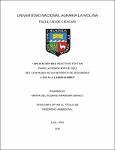Mostrar el registro sencillo del ítem
Aplicación del reactivo fenton para la remoción de DQO del lixiviado de un depósito de seguridad a escala laboratorio
| dc.contributor.advisor | Vela Cardich, Rosemary | |
| dc.contributor.author | Aranibar Bianco, María del Rosario | |
| dc.date.accessioned | 2018-02-26T15:38:16Z | |
| dc.date.available | 2018-02-26T15:38:16Z | |
| dc.date.issued | 2016 | |
| dc.identifier.other | T01.A73-T BAN UNALM | |
| dc.identifier.uri | https://hdl.handle.net/20.500.12996/3105 | |
| dc.description | Universidad Nacional Agraria La Molina. Facultad de Ciencias. Departamento Académico de Ingeniería Ambiental, Física y Meteorología | es_PE |
| dc.description.abstract | El reactivo Fenton ofrece una muy buena alternativa para el tratamiento de efluentes con carga orgánica elevada y aunque tiene fama de ser un tratamiento costoso, para el sistema en el que fue aplicado, resulta ser económico y funciona muy bien. La matriz sobre la que se realizó el tratamiento fue el lixiviado de un depósito de seguridad. El objetivo general fue determinar la dosis óptima de reactivo Fenton para la reducción de DQO del lixiviado¸ y los objetivos específicos; determinar la dosis óptima de H2O2 y la dosis óptima de Fe2+, para obtener la máxima remoción de DQO. Además, determinar la relación H2O2/Fe2+ óptima. Los experimentos se realizaron en dos etapas, la primera para la optimización de H2O2 y la segunda para la optimización de FeSO4; siendo la variable dependiente, en ambos casos, el menor valor de DQO obtenido en las muestras tratadas. Se acidificaron las muestras utilizando residuos ácidos y se dosificaron los reactivos; 24 horas después se neutralizó y filtró la muestra. El producto obtenido se diluyó para analizar la DQO y realizar los análisis de cromatografía iónica. La dosis óptima de reactivo Fenton que generó la mayor reducción de DQO del lixiviado evaluado; es 12000 mg/l de H2O2 y 5000 mg/l de FeSO4. La relación óptima de Fe2+/ H2O2 que permitió obtener la mayor remoción de DQO es 0.417. Se evidenció la degradación de la materia orgánica contenida en el lixiviado mediante la reducción de la DQO en 77.79 % y de la DBO en 97.2%; además de altos índices de remoción de metales totales | es_PE |
| dc.description.abstract | Fenton reagent offers a very good alternative for the treatment of effluents with high organic load, although it is reputed to be a costly treatment, for the system in which it was applied, it is economical and works very well. The matrix on which the treatment was carried out was the leachate of a security fill. The overall objective was to determine the optimum dose of Fenton reagent for the reduction of COD of the leachate¸ and as specific targets; determine the optimum dose of H2O2 and the optimal dose of Fe2 +, to obtain the maximum removal of COD. In addition, determine the optimum H2O2 / Fe2 + ratio. The experiments were carried out in two stages, the first for the optimization of H2O2 and the second for the optimization of FeSO4; being the dependent variable, in both cases, the lowest COD value obtained in the treated samples. The samples were acidified using acid residues and the reagents were dosed, 24 hours later the sample was neutralized and filtered. The product obtained was diluted to analyze the COD and perform the ion chromatography analyzes. The optimum dose of Fenton reagent that generated the highest COD reduction of the evaluated leachate; is 12000 mg / l H2O2 and 5000 mg / l FeSO4. The optimal ratio of Fe2 + / H2O2 that allowed the highest removal of COD was 0.417. The degradation of the organic matter contained in the leachate was evidenced by the reduction of the COD in 77.79% and of the BOD in 97.2%; as well as high rates of total metal removal | en_US |
| dc.format | application/pdf | en_US |
| dc.language.iso | spa | es_PE |
| dc.publisher | Universidad Nacional Agraria La Molina | es_PE |
| dc.rights | info:eu-repo/semantics/openAccess | en_US |
| dc.rights.uri | https://creativecommons.org/licenses/by-nc-nd/4.0/ | * |
| dc.subject | Desechos industriales | es_PE |
| dc.subject | Oxidación | es_PE |
| dc.subject | Lixiviados | es_PE |
| dc.subject | Contaminantes | es_PE |
| dc.subject | Manejo de desechos | es_PE |
| dc.subject | Gestión | es_PE |
| dc.subject | Control de la contaminación | es_PE |
| dc.subject | Métodos | es_PE |
| dc.subject | Evaluación | es_PE |
| dc.subject | Perú | es_PE |
| dc.subject | Reactivo Fenton | es_PE |
| dc.subject | Residuos sólidos | es_PE |
| dc.subject | Manejo de residuos | es_PE |
| dc.title | Aplicación del reactivo fenton para la remoción de DQO del lixiviado de un depósito de seguridad a escala laboratorio | es_PE |
| dc.type | info:eu-repo/semantics/bachelorThesis | en_US |
| thesis.degree.discipline | Ingeniería Ambiental, Física y Meteorología | es_PE |
| thesis.degree.grantor | Universidad Nacional Agraria La Molina. Facultad de Ciencias | es_PE |
| thesis.degree.name | Ingeniero Ambiental | es_PE |
| dc.subject.ocde | http://purl.org/pe-repo/ocde/ford#2.07.01 | es_PE |
| renati.author.dni | 70292602 | es_PE |
| dc.publisher.country | PE | |
| dc.type.version | info:eu-repo/semantics/publishedVersion | en_US |
| renati.advisor.orcid | https://orcid.org/0000-0002-7632-8729 | |
| renati.advisor.dni | 07617753 | es_PE |
| renati.type | https://purl.org/pe-repo/renati/type#tesis | es_PE |
| renati.level | https://purl.org/pe-repo/renati/level#tituloProfesional | es_PE |
| renati.discipline | 521066 | es_PE |
Ficheros en el ítem
Este ítem aparece en la(s) siguiente(s) colección(ones)
-
CIE-IA Tesis [282]



